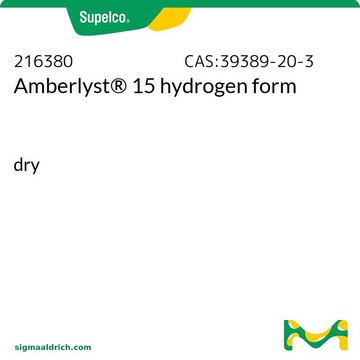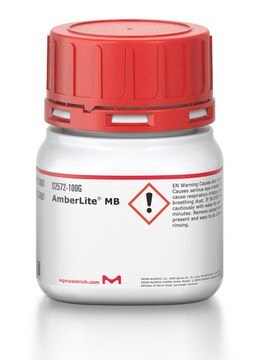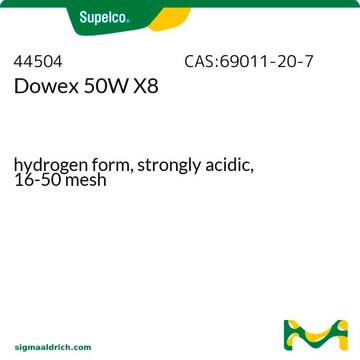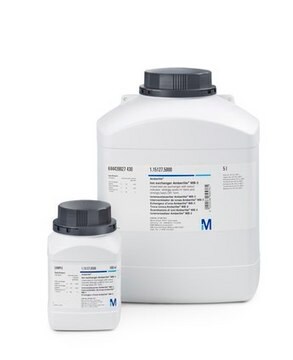436712
Amberlyst® 36 Ion Exchange Resin
16-50 mesh
About This Item
Polecane produkty
Nazwa produktu
Amberlyst® 36, total pore volume 0.20 mL/g
Formularz
beads
Poziom jakości
sieciowanie krzyżowe
12 % cross-linked
zawiera
51-57% Moisture content (H+ form)
skład
water, 55%
metody
LPLC: suitable
powierzchnia
33 m2/g
Matryca
styrene divinylbenzene (macroporous)
grupa aktywna macierzy
sulfonic acid functional group
wielkość cząstki
<0.425 mm (0.5% max)
0.600-0.850 mm (uniformity coefficient: <1.6)
>1.180 mm (4.0% max)
wielkość porów
0.20 mL/g total pore volume
240 Å average pore diameter
pojemność
>1.95 eq/L exchange capacity
>5.40 meq/g exchange capacity
gęstość
1.2 g/mL at 25 °C (lit.)
metoda separacji
cation exchange
InChI
1S/C10H10.C8H8O3S/c1-3-9-7-5-6-8-10(9)4-2;1-2-7-5-3-4-6-8(7)12(9,10)11/h3-8H,1-2H2;2-6H,1H2,(H,9,10,11)
Klucz InChI
SIWVGXQOXWGJCI-UHFFFAOYSA-N
Powiązane kategorie
Opis ogólny
Water to phenol: 45%
Water to dry: 54%
Zastosowanie
- Synthesis of renewable diesel and jet fuel range alkanes using 2-methylfuran and cyclohexanone.: This study explores a method for producing renewable diesel and jet fuel from biomass-derived compounds using Amberlyst® 36 as a catalyst, highlighting its potential for sustainable fuel production (Sun et al., 2022).
- Kinetic Study on Esterification of Acetic Acid with Isopropyl Alcohol Catalyzed by Ion Exchange Resin.: The research investigates the kinetics of esterification reactions catalyzed by Amberlyst® 36, providing insights into its efficiency and applicability in producing esters used in various industrial applications (Liu et al., 2019).
- Pretreatment of bio-oil with ion exchange resin to improve fuel quality and reduce char during hydrodeoxygenation upgrading with Pt/C.: This paper discusses the use of Amberlyst® 36 in the pretreatment of bio-oil to enhance its quality as a precursor for sustainable fuel, demonstrating the resin′s effectiveness in removing impurities that affect fuel refinement processes (Oh et al., 2021).
- Hydrolysis of Lipid-Extracted Chlorella vulgaris by Simultaneous Use of Solid and Liquid Acids.: The study examines the hydrolysis of algae-derived lipids using a combination of Amberlyst® 36 and other acids, showcasing its potential to facilitate biofuel production from microalgae (Seon et al., 2019).
- Valorization of lignocellulosic fibres of paper waste into levulinic acid using solid and aqueous Brønsted acid.: This research demonstrates the role of Amberlyst® 36 in converting paper waste into valuable chemicals like levulinic acid, contributing to waste valorization and chemical recycling (Chen et al., 2018).
Informacje prawne
Kod klasy składowania
11 - Combustible Solids
Klasa zagrożenia wodnego (WGK)
WGK 3
Temperatura zapłonu (°F)
Not applicable
Temperatura zapłonu (°C)
Not applicable
Środki ochrony indywidualnej
dust mask type N95 (US), Eyeshields, Gloves
Wybierz jedną z najnowszych wersji:
Masz już ten produkt?
Dokumenty związane z niedawno zakupionymi produktami zostały zamieszczone w Bibliotece dokumentów.
Klienci oglądali również te produkty
Nasz zespół naukowców ma doświadczenie we wszystkich obszarach badań, w tym w naukach przyrodniczych, materiałoznawstwie, syntezie chemicznej, chromatografii, analityce i wielu innych dziedzinach.
Skontaktuj się z zespołem ds. pomocy technicznej









